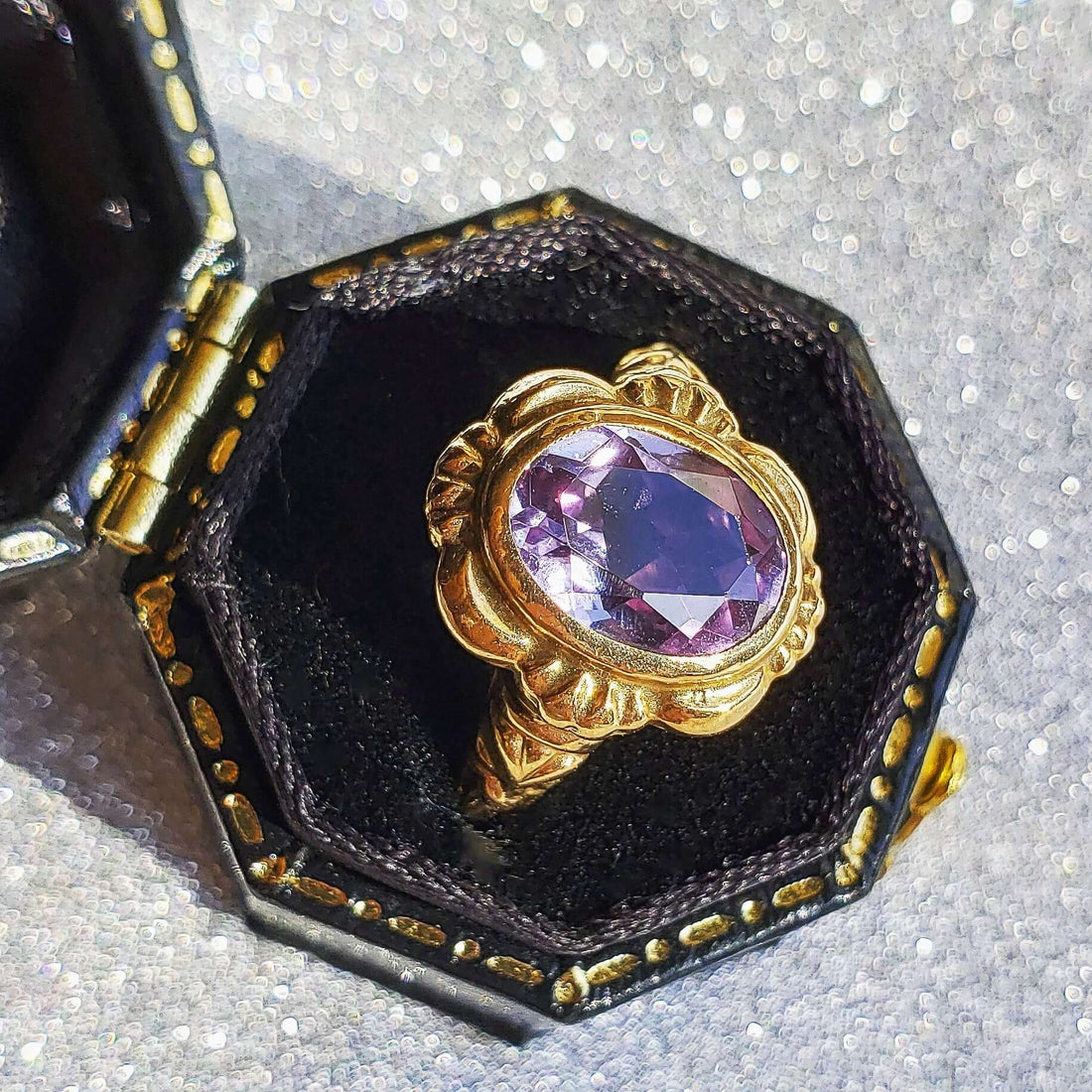
Lab-Grown/Synthetic, Imitation, and Assembled Gemstones: An Introduction
by Dani Chavez
In recent years, synthetic diamonds have transformed the diamond market, prompting major companies like De Beers to scramble to keep up. Many people would be surprised to discover that synthetic gemstones and diamonds are not a recent development; they have a long and fascinating history.
Substitutes and imitations have existed as long as humans have mined gems and minerals. So, let’s learn the difference between synthetics, imitations, and assembled stones. Synthetic gemstones are chemically, physically, and optically the same as their natural counterparts; the only difference is their creation method. Synthetic/lab-created gems are grown in a controlled lab environment, whereas natural gemstones are not.

Lab-Created Spinel Rings from 1940-1960. Image: The Gemmary
Lab-Grown/Synthetics
Humans have pondered gemstone synthesis since Theophrastus postulated in 315 BCE that crystals are produced from “the solidification of fluids; some through the action of heat, others through cold, and probably some by both means” (Nassau, 3). He even believed that amber solidifies lynx urine!
The gemstone creation theory gained significant traction 400 years later, when Pliny the Elder wrote in his famous tome that crystal is a form of ice. Fast-forward to the mid-19th century, when gem sources and mines experienced decreased productivity, and scientific advancement was in a Renaissance era, following the Industrial Revolution.
By 1905, Auguste Victor Louis Verneuil synthesized the first jewelry-caliber ruby and spinel. His scientific studies in the late 1800s laid the groundwork for modern gemstone synthesis. A few years later, in 1911, he created the first synthetic sapphire and spinel using the same techniques.
After WWII, the General Electric company successfully created the first lab-grown diamond in 1955. In fact, synthetics were widely popular during both World Wars because they were affordable, and most gem and mineral trading routes were disrupted during wartime.
Today, there are two significant methods of crystal creation: melt and solution. Melt processes, like the Czochralski or pulling method, involve melting the gemstone’s ingredients into a crucible and slowly pulling a seed crystal through the solution. Solution processes, like flux and hydrothermal, require dissolved and cooled nutrients to form crystals.
Common synthesized gemstones: spinel, sapphire, color-change, and star sapphire (Linde), emerald, sapphire, opal, turquoise, diamonds, onyx, lapis, alexandrite

Imitation Spinel Glass Necklace and Lab Spinel Ring. Image: The Gemmary
Imitations/Simulants
Imitations or Stimulants are made of entirely different materials and crafted to mimic the appearance of gemstones. They are common and can occur naturally or be shaped by humans.
Imitation gemstones are the oldest of the three, dating back 5000 years to the ancient Egyptians. Pliny the Elder recorded many “strange and artistic” names for gems, which we refer to today as “trade names” and are very misleading (Nassau, 8).
The most common imitations/simulants are glass and paste, dyed white gem material (howlite to resemble turquoise), pearls (coated beads), rhinestones, cameos, and diamonds (YAG, GGG, cubic zirconia, synthetic rutile, strontium titanate, zircon, and synthetic moissanite).

Natural Emerald and Pearl Ring and Assembled Garnet and Glass Doublet Ring. Image: The Gemmary
Assembled Stones
Finally, assembled stones are composed of two or three layers of material fused to create a faceted gemstone. Sometimes, these doublets or triplets may contain a natural gemstone portion and glass, plastic, colored glue, or other natural gemstones. These stones are commonly found in antique and vintage jewelry and can be identified with magnification.
Most common doublets: garnet and glass (green, red, and blue), ammolite, cameos
Most common triplets: opal (black base, thin opal, rock crystal dome), ammolite, synthetic spinel (class ring jewelry)
Most commonly assembled: mabe pearls, intarsias (mosaics of gemstones inlaid)
Pros of Synthetics, Imitations, and Assembled Stones
Recycling. Modern mining methods can be very destructive to the environment. Clear-cutting of tropical rainforests for diamond and gold mining is still a prevalent problem worldwide. Buying a synthetic gemstone, especially a vintage or antique one, can make a small impact on the destruction of the ecosystem.
Color and Clarity. Synthetic gemstones tend to be clearer and more colorful than their natural counterparts. Gemstone formation in the Earth tends to trap mineral inclusions and cause feathers and fractures. Synthetics are formed in a lab-controlled environment under perfect conditions.
Price. The synthetic gemstone market is more affordable because modern mining practices, especially diamond exploration, are astronomically expensive. Scientific labs are cheaper to construct, and those savings are passed onto the buyer.
Ethics. The elephant in the room about the gem and jewelry industry is exploitative mining practices to fund terrorism and war. Purchasing a synthetic gemstone ensures your money is not going towards hostile groups or movements.
Sources:
Nassau, Kurt. (1980) Gems Made by Man. Randor, Pennsylvania: Chilton Book Company.
Smigel, Barbara, PhD. (https://www.gemsociety.org/article/assembled-stones-jewelry-and-gemstone-information/).
Weldon, Robert. An Introduction to Simulants or Imitation Gem Materials. Retrieved from https://www.gia.edu/UK-EN/gem-imitation.
Weldon, Robert. An Introduction to Synthetic Gem Materials. Retrieved from https://www.gia.edu/gem-synthetic.
Weldon, Robert. Gemstone Doublets, Triplets, and Other Assembled Stones. Retrieved from https://www.gia.edu/gem-imitation.
